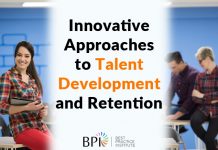For several years, I had the good fortune of working as a training and development researcher for the United States Army. It would take hours for me to even scratch the surface of all that I learned from those soldiers but here is one bit of advice I keeping returning: Beware of the Good Idea Fairy.
For those unfamiliar, the Good Idea Fairy is the source of those inspired ideas some people whiffle up for others people to implement without every really considering their practical consequences and downstream impact. When you here “It sounded good on paper” think “Good Idea Fairy”.
The Good Idea Fairy has reared its ugly head many times including wellness program design, the elimination of employee performance ratings, and the breathless “neuro-anything” movement, accurately described as “Neurotrash” (see also this research)
In some instances, the Good Idea Fairy is fed simply by ego and someone’s need to make an imprint on an organization regardless of whether the effort even attempts to solve a real problem. In other instances, the people are genuine and well-meaning but they haven’t really thought through the underlying issues, questions, or processes. In either case, you end up with wasted resources and time lost headed down the wrong path.
Fortunately, we can reduce the likelihood visits from the Good Idea Fairy and move towards solving problems by taking measurement and analysis seriously, whether we’re talking about simple descriptive analyses or complex predictive models.
But how do we get started? Do we need a team of statisticians? Data scientists? Coders? PhD researchers?
Eventually you might want a sprinkling of these types, but none of that will help unless you focus on the right process and the essential questions. If you get those pieces in order the rest will fall into place.
What is the Process?
There are many detailed, in-depth descriptions of good HR analytics processes, but you can drown in the details, loss sight of the goal, and give up before you get started.
I like to keep things simple so I break HR Analytics into four steps:
- Describe
- Understand
- Predict
- Change
Describe
This is absolutely the single most important step in the process. But description means describing someting so you need to start with a question.
But what question?
Pick something that leaders, decision makers, and HR pros talk about all the time, something of inherent concern in your specific organization. This might be turnover, engagement, talent acquisition, or some other topic.
If people think it’s important you’re much more likely to have support for your efforts and genuine engagement with your results.
Let’s stick with turnover as our example, say “Is my turnover too high?”
Assuming you are not obviously hemorraging employees at 50% a year, you’ll need to break this down a bit more.
We can dig deeper by thinking about different ways to slice and dice our workforce.
Try by first breaking it down my gender. For instance, do we have meaningfully different turnover rates by males v. females?
Depending on what you find, you may want to break it down further.
Here are just a few features to consider:
- Age groups
- Region
- Education level
- Salary buckets
- Salaried v. hourly
- Performance ratings
- Company tenure
- People leaders/ managers v. associates
- Business areas
As you go through this process of breaking down your data, two things will start to happen.
First, you’ll realize that the initial question of “Is my turnover too high” will transform itself into a much more specific set of questions and answers.
Second you’ll start to hone in on the clear systematic differences that need attention. You’ll see a mindset shift from the simplistic focus on a single number (e.g. “Turnover rate = 19%”) to “Our turnover numbers for high-potential females in the Marketing department are substantially higher than other segments of our workforce”.
That’s much more specific and more actionable.
But What About the Data?
You might be asking yourself “How do I get that information?”. This is where issues of talent and analytics expertise emerge. Obviously you need the raw data and people with the tools to handle it.
This is not an article on the ins and out of data handling for HR Analytics, but at a high level, you can break descriptive analytics skills down into the following buckets:
- Data selection
- Data cleaning
- Analyses
- Visualization
Having a couple data science horses in the barn is always handy but you probably don’t need people with the complete skill set. A reasonable mastery of standard tools like SQL, Excel, and Tableau should be more than enough to get you what you need at this point.
Don’t have those capabilities available? Find it, develop it, or hire it.
Understand
I split out Understanding as it’s own category but it honestly rests in great part on the quality of your initial descriptive work. Still, you don’t want to maintain an overly narrow focus on how YOU see the data.
The best understanding will come from sharing your initial results with trusted leaders and colleagues. Go talk to them. Send an email with a few easy-to-interpret figures. Get their feedback.
Are you overlooking something? Do these results surprise them? Is there a simple explanation? Do they run counter to the dominant storyline of the topic at your organization?
Most likely, you’ll end up wanting to go back and look at your data in a different way. You’ll take those suggestions and critiques and ask if this is the whole story or if there is something more.
As an example, suppose you find that those with higher salaries seem to leave more often. When you share your results though, someone asks if this doesn’t actually reflect the higher salaries of your sales staff who are always being poached by competitors. That’s something you never thought of.
If you want to really understand what is happening under the turnover hood you’ll need to go back to your data and take that idea into account in your next analyses.
It’s important to note that some higher level statistical skills might be required for this step. Again, you don’t necessarily need someone with a PhD but having people that can run basic linear regressions or logistic regressions will be a huge asset. Being able to tease apart the influences of age and salary from gender statistically, for example, is a huge plus when it comes to addressing the feedback you receive.
Fortunately, comparatively simple statistical models are best here because they are easy to run and readily interpretable.
Remember too that you will need to iterate through these steps. Yes, we started with description, but moving towards genuine (or at least approximate) understanding means going back to more descriptive analyses, followed by more feedback, more conversations, more sharing, and a few more statistic models.
Predict
The power of prediction cannot be overstated but prediction itself can be misunderstood.
The most important principle to remember is that prediction is not understanding. I have an entire post on this topic but the basic idea is that a model telling you THAT something is likely happen will not necessarily tell you WHY that thing will happen.
Part of the challenge of developing predictive models, then, is figuring out what your actionable goals really are and developing the right models to meet those goals.
If your goal is simply to predict the likelihood of individual employees leaving in the upcoming year, then by all means you can choose a highly complex, black-box type approach like a neural network model or ensembling to arrive at great predictions.
Such models are great for workforce planning, for example, because they can tell you what workforce holes you’ll need to plug in the upcoming year.
But black-box models are not so hot when you need to understand what is driving those future outcomes.
In those cases you may very well want a model that lacks some predictive power but compensates with big gains in transparency and human interpretability (think logistic regression with some directly interpretable factors).
This is particularly important in organizations where predictive modeling is new. In practical terms, you are much better off with a model that leaders understand and believe in than a more powerful model that only you love.
Asking yourself “What is the goal of this model?” and “What is actionable with this model?” will help you figure out what kind of models you should be building in your HR Analytics practice.
On a sidenote, as you probably figured out, you’ll need some data science expertise. As before, if you don’t have it, find it, develop it, or hire it.
Change
The last item is some kind of change or intervention that actively shapes outcomes and moves your organization in the right direction.
This happens to be the fourth item because it’s actually harder than building a predictive model. Nonetheless, you can create change without predictive modeling.
If we wanted to increase retention we could, for example, change work-at-home policies or bump up salaries in select areas in response to what we learned in our description and understanding stages. We clearly don’t actually need a predictive model for this.
What we do need, though, is a clear metric for understanding our current state and a clear measure of our success or failure.
If we don’t put measurement front and center in our change initiative, we’ll end up a ton of mushy-headed, nice-sounding programs that have no true value to the organization.
Justice Louis Brandeis once said “Sunlight is said to be the best of disinfectants”. In HR Analytics, that sunlight is measurement.
Test your actions systematically. Identify your critical “befores and afters” . Do some small A/B testing to see what might work and what probably won’t before unleashing your good idea on the whole organization. In short, test, measure, and iterate.
Final Thoughts
Everyone loves the sound of “HR Analytics” and “Machine Learning” because it seems rigorous, forward-thinking, and cutting edge….until they realize it also means asking hard questions, getting ugly answers, and recognizing that improving performance and changing human behavior is absolutely the hardest thing to do.
But there is a path. Start with description, seek understanding, predict with purpose, and measure for change. And iterate. Always, always iterate.
Above all else, get started.
Addendum
Asking the right question is critical for taking impactful action and solving problems.
There is no better, more concise guide to asking and acting than the “Heilmeier Catechism”“, developed by George H. Heilmeier, a former DARPA director and engineer at Texas Instruments.
Here is the Heilmeier Catechism, in all of its bulleted glory:
- What are you trying to do? Articulate your objectives using absolutely no jargon.
- How is it done today, and what are the limits of current practice?
- What is new in your approach and why do you think it will be successful?
- Who cares? If you are successful, what difference will it make?
- What are the risks?
- How much will it cost?
- How long will it take?
- What are the mid-term and final “exams” to check for success?
This article was originally posted via the following link:
Killing the Good Idea Fairy: 4 Steps to Actually Solving Problems with HR Analytics










